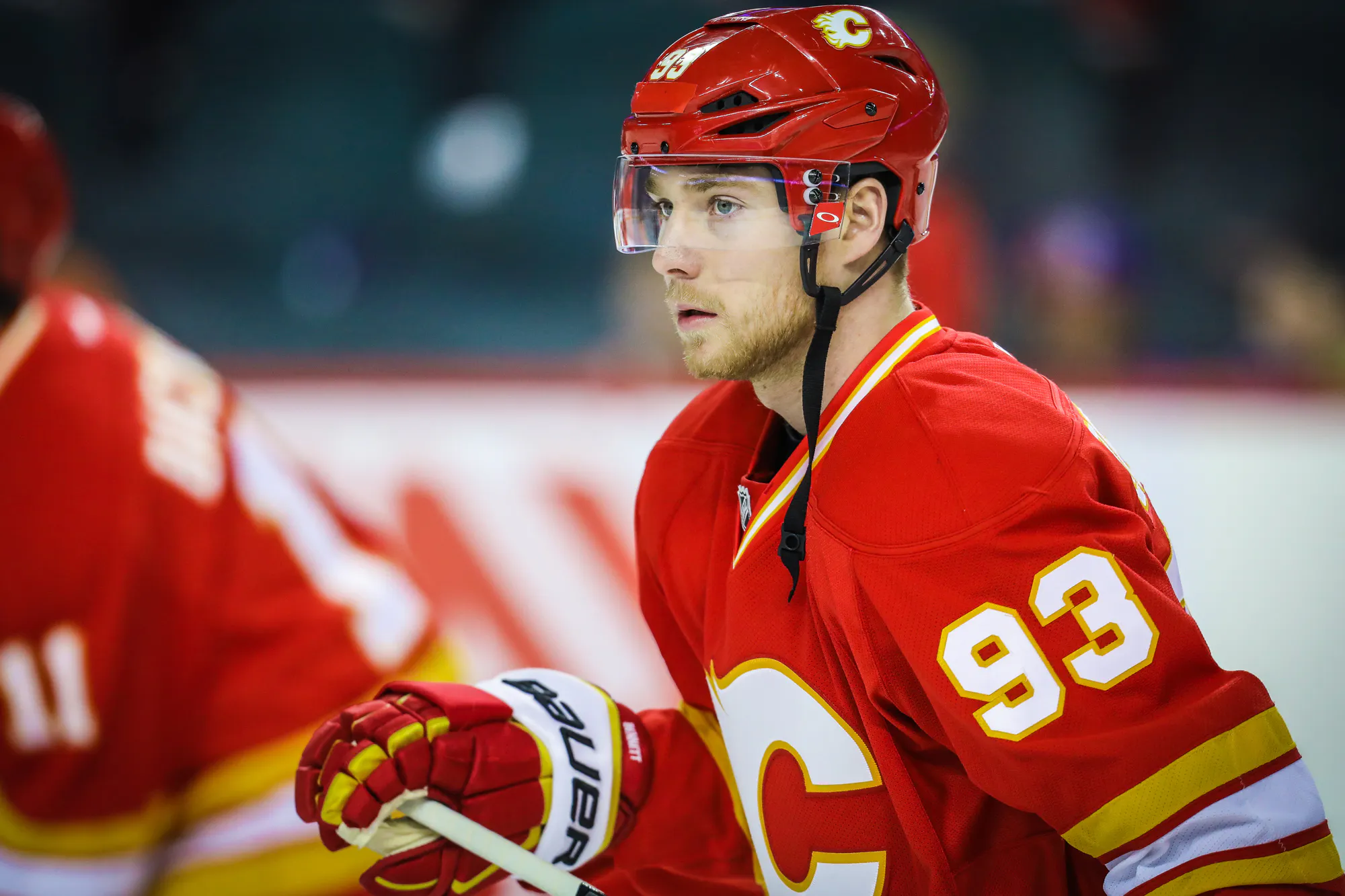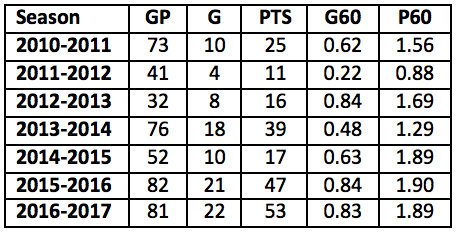Realistic expectations for Sam Bennett in year three

At some point before the start of training camp, the Calgary Flames and Sam Bennett will agree to a new contract. Sure, a deal hasn’t been agreed to as of yet, but I don’t think there’s anything to worry about on that front. Part of what has held discussions up, though, is uncertainty about what the Flames have in Bennett and how he projects going forward. With two decent, but not spectacular, seasons under his belt, should we be expecting a big jump from Bennett in year three?
While not out of the question, it’s not something I’d be banking on.
The story so far
Compared to lots of players in their 19- and 20-year-old seasons, Bennett’s first two years in the NHL have been just fine. Fair or unfair, though, being Calgary’s highest ever draft pick carries with it higher expectations than many other young players. As such, some see Bennett’s first two NHL seasons as disappointing, which I think is slightly harsh. Yes, young teammates like Sean Monahan, Johnny Gaudreau, and Matthew Tkachuk have been more productive to this point, but that doesn’t mean Bennett has been bad, either.
Productivity wise, Bennett’s first two NHL seasons look like this:
2015-2016: 77 GP, 18 G, 18 A, 36 PTS
2016-2017: 81 GP, 13 G, 13 A, 26 PTS
2016-2017: 81 GP, 13 G, 13 A, 26 PTS
And from an underlying perspective, here’s what we’ve seen from Bennett:

Bennett actually enjoyed a more productive rookie season than Monahan did, finishing with more points and a higher even strength points-per-60 rate. Despite a pair of extended goal scoring droughts, Bennett’s inaugural campaign was generally positive and expectations were high coming into last year. In fact, there was a great deal of excitement during training camp when Bennett looked like a driving force on a line with Tkachuk and Troy Brouwer. That line didn’t last long, though, and Bennett struggled to produce playing down the middle full time.
If we’re using the word disappointing, it does apply to the drop in production, both counting and underlying, we saw from Bennett in year two. If you compare rookie seasons, Bennett’s was slightly superior to Monahan’s. However, when you juxtapose what we saw from each player in their second seasons, the scale swings dramatically in Monahan’s direction.

Season two saw Monahan start to develop into a top flight centre who could be deployed against, and score against, top players on the other side; since his rookie campaign, Monahan has developed into a perennial 60-point player. For Bennett, though, year two saw steps back all over the board. He was given more offensive zone starts without a commensurate bump in possession rates and his scoring dropped significantly.
Because they were high picks taken one year apart, Bennett and Monahan are often grouped together. I don’t actually think it’s a great comparison for Bennett, though, for a couple different reasons. First, since year two, Monahan has consistently centred one of the league’s most dynamic offensive players in Gaudreau. There’s no doubt Gaudreau’s influence is large and the WOWY outputs are telling in that regard (for another article at another time).
Monahan has also seen substantially more time on the powerplay when compared to Bennett. For instance, Monahan averaged 2:50 of powerplay time per game in his second NHL season. In Bennett’s second season, that number was more than cut in half, as he averaged 1:14 of powerplay time each night. While it doesn’t affect their even strength scoring rates, powerplay time is obviously going to boost raw point totals. Ten of Monahan’s 31 goals in 2014-15 came on the powerplay, compared to four for Bennett last season.
There are better and more realistic comparisons. Going back to our RFA profile on Bennett from late April, this is the group of similar players I came up with using CapFriendly’s comparable tool. The table below charts aggregate totals for each player in the two years leading up to their second contracts.

While Flames fans would love to see Bennett in the same conversation with fellow 2014 picks like Leon Draisaitl, David Pastrnak, or even Nikolaj Ehlers, the fact is that’s not realistic. Instead, the grouping above is a closer composite of what we’ve seen from Bennett in his first two years. In saying that, all four of the above players have made larger impacts on their teams than Bennett has on Calgary.
What to expect
Projecting year three for Bennett is not an easy exercise because there are a decent number of unknown factors. We’ll do the best we can, though, and we’ll start by looking at what we saw in year three from the four players we’ve deemed realistic comparables.

With the exception of Tatar, who took a slight offensive step back, each player saw their point totals improve from year two to year three. That’s promising news for Bennett, and it would make sense to see him rebound from his difficult 2016-17 campaign. I’m not talking about him doubling his point totals, but going from 26 to 40 points isn’t out of the question at all.
So much of this conversation relies on what position Bennett plays and who he plays with. If the Flames stick with him down the middle, a big jump in numbers will be a little more difficult. As a centre, Bennett is clearly third on the depth chart behind Monahan and Mikael Backlund. On the one hand, that’ll free him up for less difficult head-to-head matchups. Conversely, though, playing Bennett at centre would decrease his ice time as opposed to him playing the wing, and might cut into his powerplay usage, too.
Furthermore, Bennett just hasn’t looked comfortable playing down the middle. Defensively he’s been fine, but Bennett has struggled with the distribution responsibilities and quick decisions that go along with the position. If that continues, I’m not expecting his numbers to take giant steps forward.
If Calgary decides to use Bennett on the wing, though, things get really interesting. For instance, what might he be able to do on a line with Monahan and Gaudreau if Micheal Ferland doesn’t fit the bill? I’ve always felt Bennett has looked far more dangerous and explosive when playing on the flank. With the burden of playing centre lifted, he’s been able to focus far more on using his offensive gifts. If I had my druthers, I’d be playing Bennett on the wing, but I’m not sure that’s the way Calgary is leaning.
Conclusion
It’s true: Bennett’s first two years in the NHL haven’t been of the spectacular variety. He certainly hasn’t put together the types of early seasons we’ve seen from other top five picks, but that doesn’t mean it’s anywhere close to cut bait time. Similarly, any talk of him being a “bust” is a little absurd at this point. There’s reason to be patient and a teammate of his is a good example of why.
Below is a season-by-season look at Backlund’s production starting with his rookie season. After a decent start, it took a while for Backlund to start producing at a solid rate. In fact, it took until years five, six, and seven for his scoring to get to a consistent level. It’s important to note that throughout his seven NHL seasons, though, Backlund’s possession metrics have always been strong, and that’s an area Bennett needs to show improvement in. Even so, the Flames were patient with Backlund and it has paid off in a big, big way. Bennett probably deserves a similar approach.

I have no clue if Bennett will progress in a similar fashion as Backlund. Maybe it’ll be quicker and maybe it won’t ever get to that level, who knows. I do know that being patient with Bennett is probably the right tactic at this point, though. As much as we like to make fun of the constant age references applied to him, Bennett is still just 21 years old. Giving up on him at this early a stage doesn’t make much sense.
But if Calgary is going to be patient with Bennett, fans probably should be, too. To expect him to double his point totals from last year is fairly unrealistic, especially if the team uses him as their number three centre. What is realistic, though, is gradual improvement in his all-around game and a step forward offensively. I think that’s a fair projection for Bennett in year number three.
Recent articles from Pat Steinberg





